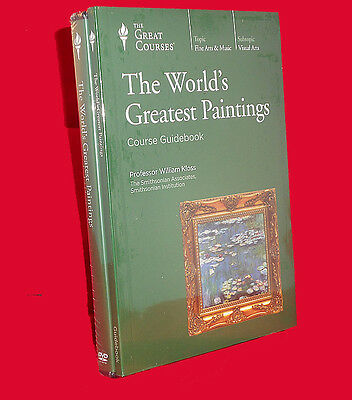-40%
NEW DVDs 24 Lectures World's Greatest Paintings Great Courses Teaching Company
$ 36.93
- Description
- Size Guide
Description
World's Greatest PaintingsProfessor William Kloss M.A.
Independent Art Historian
24 Lectures
New 4 DVD set ! Factory Sealed!
Great paintings challenge us to understand them, to penetrate their mysteries, and to appreciate their riches. But within the vast history of art, there exist only a small number of paintings that transcend the traditional role of art to become cultural signifiers—works that allow us to comprehend more deeply the world and our place within it.
So what distinguishes one of these select masterworks? Dazzling in their visual impact and their grip on the imagination, the world's greatest paintings
challenge the conventions of the art of their times, extending or transforming the painter's visual language and broadening the impact of art in Western societies;
serve as visual anchors of faith, politics, philosophy, mythology, literature, and every phase and aspect of social history; and
depict human life in visions of enduring power, reflecting and affecting the times and cultures in which they were created.
Now, in 24 illuminating lectures,
The World's Greatest Paintings
leads you in a compelling discovery of some of the most significant paintings in Western art. Taking you from the 14th century to the 20th, distinguished art historian and veteran Great Courses Professor William Kloss reveals a group of works that, in his expert judgment, rank among the greatest paintings ever made.
The World's Greatest Paintings
explores one of the supreme legacies of human life, opening rich perspectives on Western civilization through your encounter with these daring and sublime works of art.
Enter the Richness of the Painter's World
From the opening lecture, Professor Kloss demonstrates that his aim is "to make you feel welcome and comfortable in the company of paintings." With this focus, he guides you in a direct and engaging encounter with the images themselves, challenging you to consider how and why these paintings affect us, and inviting you to join him in looking deeply into the painter's multidimensional visual realm.
Focusing on 65 masterpieces of Western painting, including key works by Giotto, Titian, Vermeer, Rembrandt, and Picasso,
The World's Greatest Paintings
offers you a vivid, visceral encounter with genius, shining light on the unique technical, stylistic, and expressive achievements of each painting.
As a foundation for the inquiry, you consider ways of defining greatness in painting:
Uniqueness:
The qualities that set a painting apart from all others in a way that influences or changes the course of art
Impact:
A painting's effect on viewers, both initial and cumulative
Emotional and intellectual resonance:
The deepening, comprehensive experience of a painting, justifying its initial impression
Throughout the series, you witness the depth of painting's interface with Western social institutions, culture, and thought.
Beginning with the 14th-century religious masters, you see how painting affirmed the foundations of Christian theology in the glorious images of Duccio, Masaccio, and Grünewald. You see how painters responded dramatically to political events in David's stark portrayal of the assassinated Jean-Paul Marat and in Delacroix's allegorical
Liberty Leading the People
. And you see Western social culture eloquently revealed in scenes of life by Bruegel, Steen, Hals, and Manet.
Rather than tracing particular schools or "isms," the lectures are arranged chronologically, showing what painters of contrasting traditions and cultures were doing in the same time periods, thus following the progressive unfolding of each painter's art. And with most lectures limited to only two to three paintings, you enjoy the rare chance to hear an expert talk at length about each carefully selected work.
Landmarks of a History-Shaping Art Form
As a core feature of the course, your study of these canvases builds the skill of viewing a painting with real discernment through an enthralling examination of the elements of composition, technique, and expression.
Among many iconic works, Professor Kloss offers a fresh look at these legendary paintings:
Leonardo's
The Last Supper
: One of the most influential paintings in the history of Western art, Leonardo's magnum opus achieves an extraordinary blending of vivid psychological detail and rich theological symbolism.
Velazquez's
Maids of Honor
: The artist's tour de force composition portraying courtiers, retainers, and an implied royal presence, its technical mastery and intriguing ambiguities have been discussed for centuries.
Monet's
Water Lilies
: Monet's lush, shimmering color and light in this grand series of paintings place it at the pinnacle of 20th-century art.
Your investigation also highlights some fascinating, less familiar masterworks:
Geertgen's
Madonna with Musical Angels
: A radiant work of genius, this small-format work pulsates with layer upon layer of minute, symbolic details.
Gorky's
The Plough and the Song, 1947
: A triumph of abstract art, this glowing canvas evokes nature-based forms in a joyous, sunlit field of color.
Professor Kloss draws your attention to numerous points of entry for appreciating a painting, showing you how to evaluate composition (the artist's arrangement of pictorial elements within the frame), style, interpretation, and technical elements such as light, color, and brushwork.
Above all, the qualities of these paintings come alive through Professor Kloss's vivid demonstration of what it is to look deeply, through his richly incisive reflections on the paintings. He shows you how Rembrandt expresses deep emotion in
The Jewish Bride
through a liquid modeling of hands and jeweled fabric, in paint that "lives and moves." You share his experience as a viewer "breathing the air" of Claude Lorrain's magnificent landscapes. And, with remarkable candor, he conveys his own wrenching response to Hans Hofmann's
to JFK: thousand roots did die with thee
.
Teaching of a Rare and Penetrating Dimension
Speaking with a passionate conviction of the value of these works, Professor Kloss deepens your enjoyment by delving into the stories behind their creation and by highlighting fascinating details of the paintings.
In Van Eyck's
Madonna of the Canon van der Paele
, 1436, you learn of the highly unusual placement of a pair of eyeglasses in the composition and its relation to the biblical Magnificat in "magnifying" the Lord. You learn that the masterful pictorial composition of Whistler's mother seated in profile came about because she was too frail to stand, as originally planned. And you learn the details of Edvard Munch's dark vision while walking on a bridge at night, which found expression in his famous
The Scream
.
Taking his cue from the deeper motives that inspired these great works, Professor Kloss uses pictorial analysis to bring you directly into the presence of the extraordinary, elemental power of these paintings—their power to astonish, to uplift, to unsettle, to ultimately shake our sense of reality, leading us to richer domains of experience and of the appreciation of life.
The 24 Lectures in Detail:
1. Greatness in Painting
What makes a masterpiece? Look at criteria for defining greatness in painting, including a work's uniqueness and the quality of its impact, both immediate and cumulative.
2. The Majesty of Duccio and Giotto
Your exploration begins with two composite masterworks of Italian painting. In the Maestá altarpiece by Duccio, grasp the elements of the painting's visual impact and spatial carrying power, its dramatic composition and imagery. In the Arena Chapel frescoes by Giotto, study the powerful depictions of devotion and grief in two narrative scenes.
3. Acts of Faith—Masaccio, Van Eyck, Van der Weyden
This lecture traces landmark religious imagery in 15th-century painting. Define Masaccio's narrative ability in two biblical fresco scenes from the Brancacci Chapel. Then discover Jan van Eyck's brilliant melding of realistic portraiture and sacred images in Madonna of the Canon van der Paele, and the emotional intensity and compositional richness of Rogier van der Weyden's Deposition of Christ.
4. The Diversity of Piero, Mantegna, Botticelli
You now encounter three major painters of the Italian Renaissance. In Piero della Francesca's Resurrection, reflect on the fresco's commanding image of the risen Christ and its mathematical composition. Later, contemplate Andrea Mantegna's extraordinary innovations in "illusionistic" painting and the luminous mysteries of Botticelli's Primavera.
5. The Devotion of Bellini, Geertgen, Dürer
You continue with three extraordinary evocations of religious devotion. In Bellini's St. Francis in the Desert, witness the portrayal of the saint's passion for nature by means of divine light. Study the multilayered pictorial details enriching Geertgen's Madonna with Musical Angels and the spiritual import in Dürer's monumental Self-Portrait.
6. Masterworks by Leonardo, Raphael, Correggio
Track the dramatic interaction of the human figures in Leonardo's iconic Last Supper and the composition's rich theological symbolism. Then define Raphael's embodiment of High Renaissance ideals in Baldassare Castiglione, and the poetic eroticism of Correggio's illusionistic Jupiter and Io.
7. Great Ensembles—Michelangelo and Grünewald
In scenes from Michelangelo's stunning Sistine Chapel ceiling, study the compositional power of The Creation of Adam and the weighty emotion of the ominous Prophet Jeremiah. Continuing with a highly contrasting masterwork of German art, penetrate the mystical evocation of suffering and ecstasy in Matthias Grünewald's Isenheim Altarpiece.
8. Ideal and Real—Giorgione, Titian, Holbein
You encounter the Concert Champêtre (1510–1511), worked on by both Giorgione and Titian, uncovering the enigmatic imagery of its Arcadian scene. Then study Titian's radiant portrayal of the Virgin Mary in the Assumption and the richly detailed execution of Holbein's portrait, Charles de Solier.
9. Living and Dying—Bruegel, El Greco, Caravaggio
Explore three contrasting 16th-century masterworks. In Bruegel's Hunters in the Snow, investigate the artist's layering of descriptive scenes within a vast space. Conclude with the haunting details and symbolic compositions of El Greco's Burial of Count Orgaz and Caravaggio's The Entombment.
10. Life Stories by Ter Brugghen, Rubens, Steen
Probe Hendrick Ter Brugghen's tender, understated evocation of the healing of St. Sebastian. Then learn about Rubens's ingenuity as a court painter in his operatic Landing of Marie de Medici in Marseilles, and the masterful organization and roguish imagery of Jan Steen's The way you hear it, is the way you sing it.
11. Inside Vermeer, Velázquez, Rembrandt
Explore three introspective works of genius. In View of Delft, reflect on Vermeer's purpose in this becalmed, idealized rendering of his city. Also decode the ambiguous, philosophical composition of Velazquez's Maids of Honor, and Rembrandt's richly costumed, stoic portrayal of himself in his Self-Portrait of 1658.
12. Spirit and Thought—Hals, Rembrandt, La Tour
Study Hals's penetrating treatment of elderly women in a Haarlem group portrait. Then explore Rembrandt's expression of a couple's deep emotion through an intimate configuration of hands and fabric, and La Tour's evocation of mystical contemplation through a flame.
13. The Serenity of Poussin, Claude, Watteau
Define the measured grace and brilliant use of color, shape, and gesture in Poussin's Eliezer and Rebecca. Study the elements of Lorrain's consummate mastery of the landscape, and the dreamlike qualities of Watteau's wistful fantasy, the Embarkation for Cythera.
14. In Contrast—Chardin, Tiepolo, Gainsborough
Three diverse works reveal 18th-century achievements in painting. In a small still life, ponder Chardin's delicate, intimate portrayal of game animals in death. Then discover Tiepolo's apotheosis of fresco painting in Apollo and the Four Continents, and Gainsborough's ingenious melding of sitter and landscape in his portrait Mrs. Richard Brinsley Sheridan.
15. Dark Images of David, Goya, Friedrich
Portrayals of brutality open this lecture. Observe David's merging of idealized presentation and realism in the stark Death of Marat, and Goya's bitter vision of military retaliation in Third of May, 1808. Finally, study the Romantic evocation of nature in Friedrich's Man and Woman Contemplating the Moon.
16. The Worlds of Constable, Turner, Delacroix
Compare the styles and originality of British landscape masters Constable and Turner, highlighting Constable's compositional technique and signature cloud-filled skies, plus Turner's bravura use of color and light. In Delacroix's Liberty Leading the People, examine the artist's allegorical fusing of symbol and reality in the heat of France's 1830 revolution.
17. Dark to Bright—Courbet, Church, Monet
French and American canvases reveal bold innovations in 19th-century painting. Contemplate the elements of Realism in Gustave Courbet's sprawling, slow-motion composition of a rural funeral, followed by Frederic Church's dynamically original depiction of Niagara Falls. Then study Monet's blaze of sunlight and color on a snowscape in The Magpie.
18. Alone and Together—Whistler, Degas, Renoir
In the ever-familiar image of Whistler's mother seated in profile, observe the superlative blending of abstract, formal composition with the intimate portrayal of a living woman. Follow with the pictorial riches and psychological ambiguities of Degas' In a Café, and the virtuoso staging and color of Renoir's Luncheon of the Boating Party.
19. Unlike Any Other—Sargent, Manet, Seurat
In John Singer Sargent's elusive portrait of the daughters of a friend, ponder the unusual placement and psychological separation of the subjects. Then, explore the deliberate unreality of Manet's Bar at the Folies-Bergère, and Seurat's suspended, Pointillist rendering of Parisians in A Sunday on La Grande Jatte.
20. Close Observation—Cézanne, Van Gogh, Homer
Uncover the structural geometry and unity of focus in Cézanne's The Card Players, as they create the weighty, timeless concentration of the figures. Also witness the structure and balance of Van Gogh's sun-baked vista in The Harvest, and Winslow Homer's dramatic merging of self with subject in Fox Hunt.
21. The Human Condition—Munch, Matisse, Schiele
Analyze Munch's pictorial composition of The Scream, as its pulsating visual field embodies the figure's cry of psychic terror. In stunning contrast, study Matisse's lyrical, floating colors and figures in The Joy of Life, then conclude with Egon Schiele's The Family and its bold evocation of his own hopes and fears.
22. Art in Time of War—Monet and Picasso
Two milestones of 20th-century art: Learn about the creation and the architectural display of Monet's transcendent series of water-lilies, parsing his superlative brushwork reflecting sky, clouds, and sunlight on water. Then take apart the writhing, nightmarish images in Picasso's Guernica, evincing his pained response to the atrocities of war.
23. Time and Memory—Magritte, Hopper, Gorky
In Magritte's Time Transfixed, observe how the artist calmly dislocates our sense of temporal and physical reality. In the famous Nighthawks, study Hopper's careful, deliberate design evoking the silent separateness of the figures. Finally, trace Gorky's inspired craft in bringing to life the joyful explosion of color in The Plough and the Song.
24. Expressive Abstractions—Pollock and Hofmann
Track Jackson Pollock's whole-body approach to putting paint on canvas, and tease out the layered color fields in his elemental force of nature, Lavender Mist. Then contrast Hans Hofmann's mastery of geometry and color with his brutal, agonized creation, to JFK. Conclude with reflections on the power of great art.









